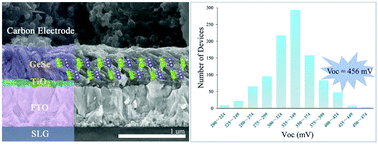Highly oriented GeSe thin film: self-assembly growth via the sandwiching post-annealing treatment and its solar cell performance†
Abstract
GeSe is considered as a potential absorber material for thin film solar cells owing to its ideal band gap, strong light absorption, remarkable air durability, Earth-abundance and non-toxic constituents. However, the high vapor pressure of GeSe at a temperature below its melting point makes it difficult to synthesize a high-quality GeSe film. To alleviate this limitation, in this work, a thermal evaporation combining a novel sandwiching post-annealing method was introduced to deposit high quality GeSe thin films with (100)-orientation. The self-assembling mechanism of the highly oriented GeSe film was carefully investigated by the systematic experiments and confirmed by the lowest total energy of the (100) crystal plane. Finally, the fully-inorganic, low-cost and non-toxic planar device with the superstrate configuration of FTO/TiO2/GeSe/carbon/Ag was also successfully fabricated. Notably, as a result, an impressive open circuit voltage (VOC) of 340 mV (maximum: 456 mV) was achieved, which is the highest VOC of GeSe solar cells reported so far. Furthermore, through current–voltage, capacitance–voltage profiling and drive level capacitance profiling measurements, it was demonstrated that the limiting factors of the GeSe solar cell performance were the narrow depletion width (138 nm) and the drastic recombination at the TiO2/GeSe interface.



 Please wait while we load your content...
Please wait while we load your content...